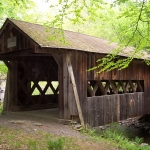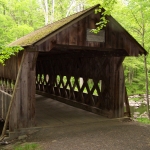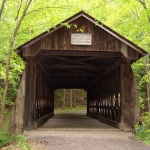ASHOKAN / TURNWOOD COVERED BRIDGE ULSTER COUNTY NY-56-05
Built in 1885 by Nelson Tompkins and moved in 1939 to its current location. A single span of 62′ crossing an old channel of Esopus Creek. Displays a Town truss. Follow Rt. 213 through Olive Bridge to Rt. 28A. Turn right for 1.5 miles, then right on Beaverkill Rd. for 1 mile. Gate to The Ashokan Center will be on your right. Approximately .5 mile walk to the bridge. A Day Pass is required to visit this bridge. Please visit the Ashokan Center website to view available days and purchase a Day Pass in advance. GPS: N41° 55.673′ W074° 11.755′
ASHOKAN / TURNWOOD BRIDGE NY-56-05
The Ashokan / Turnwood Bridge was also known as the New Paltz Campus Bridge, being on a former satellite campus of SUNY New Paltz – the grounds of the current Ashokan Center. It was originally constructed by Nelson Tompkins in 1885 and is listed on the National Register of Historic Places as of July 20, 2000.
It is located in the Town of Olive, south of Beaverkill Road approximately one-half mile, or so. It is over the Esopus Creek, a single span of 62 feet and displays a Town truss. It was moved to the present location in the 1930’s. This is a PRIVATE BRIDGE, please ask permission. A Day Pass is required to visit this bridge. Please visit the Ashokan Center website to view available days and purchase a Day Pass in advance.
Directions to the bridge:
Follow State Route 213 through Olive Bridge to State Route 28A. Turn right and proceed 1.5 miles, then turn right onto Beaverkill Road for 1 mile. Gate to the Ashokan Center will be on your right. Approximately .5 mile walk to the bridge. A Day Pass is required to visit this bridge. Please visit the Ashokan Center website to view available days and purchase a Day Pass in advance.
ASHOKAN-TURNWOOD COVERED BRIDGE
The Ashokan-Turnwood Covered Bridge (formerly known as the Olive Bridge and most recently,the SUNY New Paltz Campus Covered Bridge)is one of five covered bridges still standing in Ulster County. It is maintained by the Ashokan Foundation and carries pedestrian traffic across Esopus Creek.
Built by Nelson Tompkins in 1885, this 62-footlong,single span structure incorporates the Town lattice truss design patented on January 28, 1820,and again in 1835 by Ithiel Town of New Haven,Connecticut.
The Ashokan-Turnwood Covered Bridge is very similar in dimensions and design too there bridges in the Catskill region, all of which feature buttresses. The Ashokan-Turnwood has two such buttresses on each side.
This beautiful, well-preserved bridge originally stood over the Beaver Kill in Turnwood, New York, a hamlet in the Beaverkill Valley in Hardenbergh. The Beaverkill Valley is an isolated, rural area tucked into the Catskill Mountains. A small hand-turning mill, owned by Hooper Tripp, gave Turnwood its name.
The principal road leading to it, Turnwood Road, passed through the covered bridge by the junction of Cross Mountain and Beaverkill Roads. Therefore, the bridge sat very close to the town’s center of activity. In the early 1900s, children of the valley residents often visited the local store to buy a tasty specialty – hot roasted peanuts. And from there, it was not uncommon for the youngsters to drift over to the bridge to play and climb inside.
A bit of intrigue involves the identification of the builder of this bridge. Old carefully painted letters on an inside truss say “Built 1885 by N. Tompkins,” yet some notable texts on covered bridges state it was built in 1889 by Frank Mead.It appears that this credit to Mead was initiated through a Margaretville newspaper which once printed that Frank Mead of Dunraven built several bridges in that area including the Turnwood bridge. Through some correspondence between author Stott Anderson and a Mr. John Peterson of Margretville, this was later proven incorrect. Apparently after the news article was printed, Mr. Peterson had taken it upon himself to investigate this news story and arranged an interview with Mead. In correspondence between Peterson and bridge enthusiast Anderson, the story unraveled.When cornered, Mead admitted he had never built any bridges, but claimed as a lad he had helped his father, William Mead, who worked with another man, Nelson Tompkins, in the bridge building trade. In the Dunraven area, for instance, they constructed the Halls bridge in 1869. Mead “laid” it out and Tompkins did the construction.
From information read in Ward Herrmann’s book, Spans of Time, Covered Bridges of Delaware County, NY, there was indeed a man by the name of Nelson Tompkins. He lived on the Barkaboom stream which is in the vicinity ofthe Beaverkill Valley. He is credited with building the Union Grove Covered Bridge over this stream. “He lived up the Barkaboom brook and used to build covered bridges. He was the engineer with a crew working for him.” From this, it is fairly safe to assume that the bridge’s inscription, “Built 1885 by N. Tompkins,” is correct.
This covered bridge did not have a paid “bridge snower” as was the custom during the time. Instead, it was the general practice for travelers to carry their own shovels and, if it became necessary, spread out enough snow to get their sleighs across.
The Turnwood Bridge was no exception when it came to harboring teams of horses in a downpour of rain. Two teams could get undercover. This was no problem if both teams were going in the same direction. However, if they happened to be facing each other, someone eventually had to back up.
It is not unusual for the Beaver Kill to flood. But the bridge was sturdy on its abutments and even raging torrents lapping at its undersides did not cause it anxious moments. As the years passed, however, the bridge’s position began to be troublesome. The road approaching from both sides made sharp angles into the bridge. This was suitable for horse drawn vehicles, but not for automobiles. In June 1934, due to traffic difficulties and the fact that the span was now nearly 50 years old, the town recorded in its books that the bridge had become unsafe.No immediate action was taken, but when the flood in October 1938 eroded the earth around the abutments, a new steel highway bridge was built the following year by the Phoenix Bridge Company of Pennsylvania just downstream from the wooden span. To dispose of the old wooden bridge, the county put it up for auction and the bidding took place on the steps of the County Court House in Kingston. It was here in 1939 that Mr. Lester A. Moehring, the comptroller of the Chrysler Corporation, bid and won the structure for $1.00.
When the new steel bridge was completed, Mr. Moehring had the lattice work unpegged and the trusses dismantled and moved by truck to his Olive property where the bridge was reassembled. From this point on, the bridge had a new identity and was called the “Olive Bridge.”
About 1944, Mr. Moehring died and in 1955 his wife sold their property, including the bridge, to Mr. and Mrs.Frank V. Banks who named their new estate, “Barrington Lodge.” It wasn’t until 1957 that the State University of New York bought the land and called it the Ashokan Field Campus of SUNY New Paltz. An environmental education program offered a one-week period to study the natural history of the area as well as research early American crafts and learn the roles of various craftsmen, including blacksmithing, tinsmithing, printing, glassblowing and making pewter. In 1966, new concrete abutments were poured under the Olive Bridge to keep it from falling into the stream.
When the Field Campus came up for sale, the Ashokan Foundation, Inc., a tax exempt, non-profit organization, was formed to preserve the property, continue the programs, and develop a new vision for the future combining nature,history and the arts and to rebuild the camp as a model of sustainable/energy efficient operation and design. The Ashokan Foundation has joined together with the Open Space Institute and the NYC Department of Environmental Protection to make these goals a reality.
Excerpted and revised from Timbers of Time by Patricia Bartels Miller.



